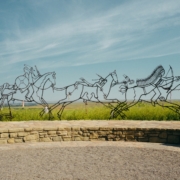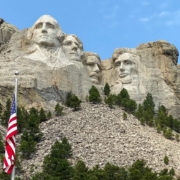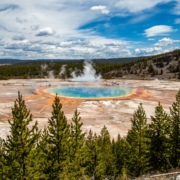The United States of America has a long history littered with conflicts that shaped it into what it is today. Many, many years ago, during the Great Sioux Wars, a great battle took place in what is now modern-day Montana. This battle, called the Battle of Little Bighorn, was significant in those wars. While the Sioux and Cheyanne warriors won the battle, their victory was temporary. Eventually, the United States government won the wars, its immense power overtaking the efforts of the Native American warriors.
Today, a monument commemorates this great battle. It draws countless visitors every year, each coming to view the site where the fateful conflict took place. It’s one of many stops on Caravan’s Yellowstone and Mount Rushmore tour, which explores the American West, including various parks and historical sites (like Little Bighorn). If you want to enjoy a Little Bighorn tour (and more), this excursion is an excellent way to do it!
The Historical Significance of Little Bighorn
Little Big Horn, now home to a museum, bookstore, and similar mementos commemorating history, was once the site of a great battle. The Battle of the Little Bighorn, also known as Custer’s Last Stand, was one of the most ruthless battles of the Sioux Wars.
The battle raged for less than an hour on June 25, 1876, near the Little Big Horn River in present-day Montana. The United States Army’s 7th Cavalry Unit, comprised of just 210 men, challenged thousands of Lakota Sioux and Northern Cheyanne warriors.
The much smaller cavalry unit stood no chance against the Native American warriors, yet they attempted to hold their own. Given the drastic disparity in numbers, the battle was over rapidly. The entirety of Custer’s men, including Custer himself, were killed in less than an hour. The brutal, ruthless battle left the cavalry unit decimated in mere minutes.
Why Did the Battle at Little Bighorn Happen?
The Battle at Little Bighorn was part of a series of battles and negotiations between U.S. forces and the Plains Indians. The United States government had repeatedly gone back on its word, breaking multiple treaties it had made with Native American Tribes.
This particular battle resulted from the broken Second Treaty of Fort Laramie. This treaty promised the Lakota, Dakota, and Arapaho tribes exclusive possession of the Dakota Territory, located west of the Mississippi River. Unfortunately, when gold was found in the Black Hills, located in present-day South Dakota and Wyoming, the government went back on its promises.
Miners were flocking to the Black Hills in search of gold, and since the government could not convince the Lakota to sell the land, it went a different route. The U.S. government began pushing to move Native Americans to reservations, further constricting their already reduced land. So, when the government broke the Second Treaty of Fort Laramie, alongside other treaties, skirmishes broke out as the Native Americans pushed back.
The Battle of Little Bighorn was just one of many battles between U.S. forces and the Plains Native Americans. While the Natives were wildly successful in this particular battle, the United States government ultimately won the Sioux Wars.
What to Expect When Visiting Little Bighorn
When you visit Little Bighorn, you’ll get to see the very site where the brutal, merciless battle took place so many years ago. It’s a step back in time, offering an abundance of information about the battle and how everything played out.
If you’re willing to go for a stroll, follow the Deep-Ravine Trail, which will take you to the site where the fighting occurred. It’s a sobering experience, seeing the battleground and recognizing that this very spot was where hundreds of men, Native American and Calvary men alike, drew their final breaths.
While you’re there, visit the museum and monuments. The monuments include the 7th U.S. Cavalry Memorial, a commemorative marker for each soldier who lost their life in battle, and an Indian Memorial. Inside the museum, you’ll find period attire, guns, and artwork depicting the battle. There’s even a 25-minute presentation video that offers in-depth information about the battle and its historical significance.
You can also learn more about Little Bighorn on the various tours. For example, there’s an Apsaalooke Tour that buses visitors to the battlefield, sharing information about the battle along the way. Or, if you prefer to drive yourself, take the 4.5-mile Little Bighorn driving tour using your cellphone, which provides an audio tour of the battle through stops along the road.
Caravan’s Yellowstone and Mount Rushmore Tour: At a Glance
If you’re ready to immerse yourself in the history of the United States and spend time exploring national parks and historical landmarks, our Yellowstone and Mount Rushmore tour might be the perfect fit. Here’s a quick overview of the 9-day tour:
- Day 1: On your first day, you’ll fly into Rapid City, South Dakota. Make your way to your Rapid City hotel, where you’ll spend the first three nights of your trip. We’ll kick off the tour with a welcome briefing at 7:00 p.m.
- Day 2: On your second day, you’ll get to explore the Badlands National Park, a nearly 250,000-acre park teeming with wildlife and striking geologic deposits.
- Day 3: Most of the second day is spent visiting Mount Rushmore and Crazy Horse Memorial. The sheer size and accuracy of the faces carved into Mount Rushmore are a sight to behold. Crazy Horse Memorial, which is still undergoing construction over 50 years after it began, is a beautiful tribute to the Sioux Lakota Indian Leader Crazy Horse.
- Day 4: On the fourth day, you’ll head west, hitting a few notable stops throughout the high plains. This includes a photo stop at Devils Tower National Monument (weather permitting), the western cowboy town of Sheridan, and the Little Bighorn Battlefield tour in the Crow Nation.
- Day 5: Day five is dedicated to Yellowstone National Park. It starts with a journey along the Lewis and Clark Trail to Livingston, eventually meandering into Yellowstone National Park. Enjoy the multiple stops along the way, including Mammoth Hot Springs, Lamar Valley, and Yellowstone’s Grand Canyon, home to Yellowstone Falls.
- Day 6: If you still have a bit of exploring to do in Yellowstone, don’t worry—part of the day is allocated to this incredible park. On day six, you’ll explore the lower loop of Yellowstone, stopping at Midway Geyser Basin, Fountain Paint Pots, and Old Faithful. After lunch, you’ll continue to the Grand Teton National Park, home to jagged, picturesque peaks and incredible sunsets.
- Day 7: On the seventh day, you’ll have some downtime during the morning. Join the included excursion to downtown Jackson Hole, or explore the area on your own. In the afternoon, the focus returns to the Grand Teton National Park, including a 10-mile raft ride along the Snake River (weather permitting).
- Day 8: Day eight brings you from Wyoming to Idaho, crossing the Oregon Trail along the way. Explore Salt Lake City, the capital city of Utah. You’ll take a brief sightseeing drive, seeing the Utah State Capitol Building, Temple Square, and Mormon Tabernacle (unless it’s closed to the public at the time).
- Day 9: The ninth day closes out your tour. After breakfast, take the provided transfers to the Salt Lake City Airport.
If you’re up for an adventure and hate planning trips yourself, guided tours are the way to go. This particular tour is an incredible experience packed with intriguing stops, from the towering peaks of the Grand Tetons to the sobering site of the Battle of Little Bighorn. You’ll get to hit some of the best spots in the West, all packed into a single trip.
And (arguably) the best part? You won’t have to plan the details. Simply plan your flights—we’ll take care of the rest, including lodgings, transportation, and meals (although we left a few meals open, just in case you wanted to sample the cuisine of a restaurant that caught your eye). It makes traveling easy. This way, you can kick back, relax, and enjoy your vacation to the fullest, all without sweating the details.
Revel in the History of Little Bighorn on a Trip With Caravan
Ready to embark on a journey to the great American west? Our Mount Rushmore and Yellowstone tour is here to bring you to the wonders of the west. Whether you want to explore the intriguing history of the U.S. or wander through the inherent beauty of the many national parks in this area, this tour has something to offer. So, if you’re chomping at the bit to book your excursion, call us today at 1-800-CARAVAN or 1-312-321-9800.


